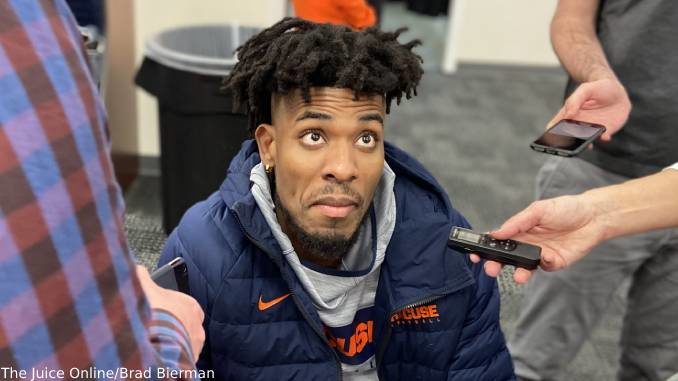
With the Syracuse basketball team recently swapping out reserve centers and their football counterparts bringing in a highly-ranked quarterback prospect through their respective transfer portals, it is pretty clear that the Orange are invested in the collegiate form of free agency.
While those two programs are at different places and have different reputations in their separate sports, there are some threads that the pair share. Basketball, and its much smaller roster, make for a quick analysis of where SU fits in the new world of the transfer portal.
Syracuse basketball and football players can mostly be sorted into four barrels:
- player who starts or plays a lot
- player who plays some, but feels they should play more, including if likely blocked by another player in the future
- player who plays little, but wants to play more and likely takes a step down to get that playing time
- player who is happy at the school overall, regardless of amount playing time
The first group is self-explanatory, filled with players who had a starting spot or filled a rotational role sizable enough during the most recent season to suggest the same amount or more playing time in the future. The last group is filled with fringe players who recognize they are not going to earn a substantially bigger in-game role, but are happy with the overall experience at SU.
Basketball players often find themselves quickly in their corresponding barrel while their football-playing counterparts, due to the sheer number of players on a roster combined with the different physical development needs, often take a little longer to land in the appropriate barrel.
The middle two barrels are where things become fluid, but the basketball team is filled with examples that likely carry over to football.
When analyzing how Jim Boeheim doles out bench minutes last month, I noticed that the players who played the most minutes off the bench for Syracuse tended to do one other thing – transfer out of the program. After the last eight seasons (the first season in this span is the one where the Orange opted out of the postseason due to a looming NCAA penalty), there were 21 different players who ranked between sixth and eighth on the basketball team in minutes played (DaJuan Coleman, Frank Howard, and Howard Washington each did it twice). One of those players, Chris McCullough, who likely would have finished in the top five in minutes in his lone season without a season-ending injury, turned pro.
Of the other 20 players, 11 opted to transfer out of SU. That transfer total does not include Quincy Guerrier, as he transferred out after he finished second in minutes played after finishing sixth the previous year. And most of those players left well before the transfer portal existed.
Ron Patterson, B.J. Johnson, Kaleb Joseph, Taurean Thompson, Matthew Moyer, Jalen Carey, Brycen Goodine, Howard Washington, Kadary Richmond, Robert Braswell, and Frank Anselem all transferred out of the Orange program in that time. While most had different circumstances leading to their departures, all fall neatly into one of the two “play more” barrels.
Some saw their roles diminish at SU (Joseph, Moyer) while others wanted more opportunity because their path to playing time was blocked (Anselem, Carey). Most took a step down in competition, landing at programs outside the Power Six of basketball.
In any case, a desire for more playing time was the root of those player departures, whether the player landed at Seton Hall, Georgia, Butler, LaSalle, Charlotte, or another school.
The incoming Mounir Hima goes against that current, taking a step up from Duquesne to Syracuse. That said, Syracuse does offer the appeal of a higher-level program willing to take a chance on a player with potential, albeit one who will be blocked from substantial playing time by Jesse Edwards.
» Related: Former Syracuse OL predicts 2022 team heading to postseason
The football team is also involved with the same two barrels of players in the transfer portal, only they are generally on the other end from the basketball program. The Orange football team is a half-step down the ladder, providing a landing place for players in their quest for more playing time while seeing their own players move to lesser programs.
Bralyn Oliver from Louisville. Dan Villari from Michigan. C.J. Hayes from Michigan State. Carlos Del Rio-Wilson from Florida. All moved from higher profile programs to SU, viewing the Orange as a place to break into the lineup faster than their previous home.
Generally, the players who left the football program did the same. Jarveon Howard transferred to Alcorn State. Dillon Markewicz left for Texas State. Adrian Cole, Latarie Kinsler, and Sharod Johnson all committed to Florida International. Curtis Harper, who was a rotational player on the defensive line last season, opted for the greener pastures of Akron.
Like his basketball-playing counterpart Mounir Hima, Juwuan Price probably was not expecting being on the fast track to playing time after taking a step up in level of competition from New Mexico State to Syracuse, as well as joining a depth chart with Sean Tucker already on it. It is possible, however, that a depth role at SU this season could turn into a starting spot for Price next year.
Either way you look at it, coming or going, Syracuse is a middle of the road stop in the transfer portal.
For more Syracuse coverage, like us on Facebook, follow us on Twitter and Instagram, and listen to our podcast.

